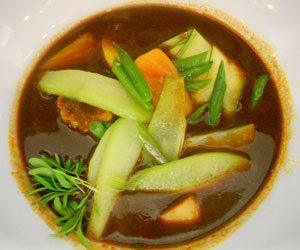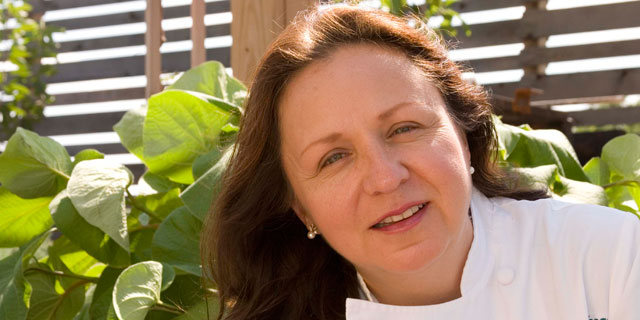Iliana de la Vega is a woman of perpetual evolution and reinvention. I became aware of her devotion to the kitchen, her love of food, and her fierce professional reputation even before we met. On a family trip to Oaxaca, my oldest son, who was 11 years old at the time, fell in love with the traditional mole at her restaurant, El Naranjo. His young culinary revelation was proof to me that Illiana was a chef among chefs, whose cooking even spoke sincerely to children.
Illiana and I finally connected in 2010, when we both started working at The Pearl Brewery in San Antonio, Texas, home of the newest branch of the Culinary Institute of America (CIA). I was a little nervous, as I had heard she was a tough cookie in the kitchen, but after a few meetings over coffee and exchanging a few of our favorite kitchen gadgets, we became close friends.
Iliana, who grew up in Mexico City, moved to Oaxaca after marrying her husband, architect Ernesto Torrealba. There they opened El Naranjo, focusing on Oaxacan style Mexican cuisine, and quickly established the restaurant as a destination in Oaxaca for international visitors who wanted to experience the quintessential regional dishes. Unfortunately, local violence and civil unrest made Oaxaca unsuitable for running a business and raising a family, so Iliana and her husband immigrated to the United States in 2006, where they settled in Austin, Texas.
There, she accepted a position as an instructor at the Center for Foods of The Americas at The CIA. Daily, she made the 90-minute commute to San Antonio from Austin, returning in the evenings and on weekends to run the next manifestation of El Naranjo, a Oaxacan cuisine food truck in Austin.
 Recently, Iliana stepped down from her position at the CIA, to dedicate her time to the newest version of El Naranjo, opened in May of 2012. The food truck morphed into an airy, sophisticated Latin American bistro housed in a 19th century cottage in the hip night life district on Rainey Street in Austin. Working in the kitchen alongside her husband and her daughters, Anna and Isabel, the De La Vega/Torrealba family continues to serve the simple, yet sincere flavors that epitomize Oaxacan cuisine. Of course, I was happy to see that they brought their treasured recipe for mole to the new El Naranjo.
Recently, Iliana stepped down from her position at the CIA, to dedicate her time to the newest version of El Naranjo, opened in May of 2012. The food truck morphed into an airy, sophisticated Latin American bistro housed in a 19th century cottage in the hip night life district on Rainey Street in Austin. Working in the kitchen alongside her husband and her daughters, Anna and Isabel, the De La Vega/Torrealba family continues to serve the simple, yet sincere flavors that epitomize Oaxacan cuisine. Of course, I was happy to see that they brought their treasured recipe for mole to the new El Naranjo.
I finally caught up with Iliana between culinary events in Austin to ask her some more personal questions about her kitchen career.
How long have you been in the kitchen?
Since an early age, around 8 years old, but professionally about 25 years. I loved to go with my Mom to the markets, and learned from her how to choose the ingredients. I used to help her (or better said, bugged her) while she was cooking. One of my first memories was making albóndigas and desserts for family.
When did you first know you wanted to be a chef?
When I was about 20 years old, I wanted to go to France to study cooking, but I never went. I am a self taught chef: I studied a lot, practice a lot, and just for fun, I entertain a lot…cooking for friends and friend’s parties. Then, I began to teach and I've been doing that for over 20 years.
What and who influenced you the most in your career?
The great cooking of my Mom and my aunt! And also a great Mexican chef, Arnulfo Luengas. My mom cooked a lot of Oaxacan, Mexican dishes but what intrigued me the most was when she cooked with chiles, like for example moles. My aunt had a ranch, so besides the everyday cooking, she also liked to make cheese, cream, butter, ice creams, and bread. Chef Luengas was born in Oaxaca, and started his career as a dish washer. He eventually moved into food prep, and was so talented, that after a while he went to France, and studied there. Once he returned home, and he became the VIP executive chef for one of the largest banks in Mexico. Chef Luengas reintroduced native ingredients and techniques into fine dining in Mexico.
Three words that describe your menu selections:
Traditional, made from scratch, labor intensive, fresh. (Hey, that’s four!)
What inspired your menu?
Mexico.
How did your restaurant get its name?
It means the orange tree. The name derived from an old and beautiful orange tree that was in the central patio of the colonial house where we had the restaurant in Oaxaca. The name synthetizes the essence of the Mestizo cuisine of Mexico; the mix of Indigenous and Spanish. Oranges were among the first trees planted by Spaniards in Mexico.
Restaurant dishes are a communication between the chef and the customer. What are you trying to communicate to those dining at your restaurant?
What we cook at the restaurant is what we feel is Mexican cuisine. At El Naranjo, we showcase the freshness of the ingredients, and use traditional techniques to create complex, bold flavors.
What has been the most difficult aspect of starting a restaurant?
Permits to remodel the house!!!!! And then finding the right people that understand our way of cooking.
What has been the most gratifying aspect of starting a restaurant?
The feedback from the people… I love the interaction with the customers, getting to know them, and hearing that they like our food! Also, I now realize that many people have followed us since we were in Mexico. At least one person every day says that they had been in Oaxaca, and ate in our former restaurant there, and that the food we are serving in the U.S. is just as good as they remember.
What is your favorite detail in your restaurant?
The food! Also, the people who work with us to make this effort come alive! I really like our restaurant’s ambiance — simple and inviting.


![Making Mealtime Matter with La Familia: Easy Sofrito [Video]](https://thelatinkitchen.com/wp-content/uploads/2015/10/sofrito-shutterstock__0-500x383.jpg)
![Easy Latin Smoothies: Goji Berry Smoothie [Video]](https://thelatinkitchen.com/wp-content/uploads/2015/12/goji_berry-shutterstock_-500x383.jpg)
















![Fun and Fast Recipes: Fiesta Cabbage Salad [Video]](https://thelatinkitchen.com/wp-content/uploads/2015/11/fiesta_cabbage_slaw-shutterstock_-500x383.jpg)









